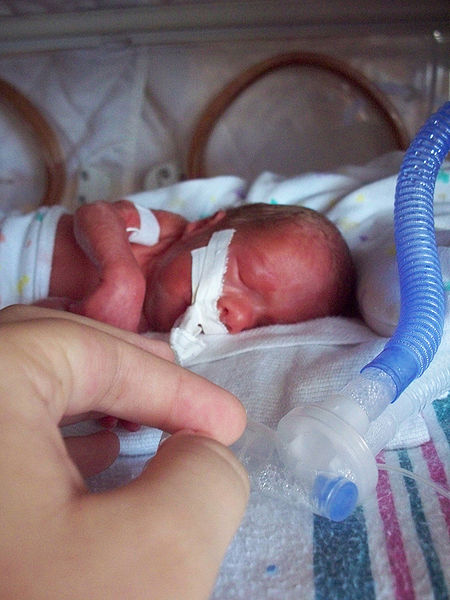UPDATE: Josie Duggar- It’s Tough Being a Micro-Preemie

In a previous story, we reported on 18 Kids and Counting mom Michelle Duggar having to undergo an emergency C-section because of a complication of pregnancy called preeclampsia. Baby Josie Brooklyn Dugger was born at 25 weeks gestation and weighed 1 pound 6 ounces. In this week’s People magazine, Michelle and husband Jim Bob Duggar talk about some of the difficulties associated with being born so prematurely, and about how well Josie is doing now. About a week about birth, Josie developed a bowel perforation (a hole in the bowel). She was transferred to the Neonatal Intensive Care Unit (NICU) at Arkansas Children’s Hospital in Little Rock for non-surgical treatment. According to her physician, Dr. Robert Arrington, co-director of the NICU, “She developed a spontaneous bowel perforation. She responded to placement of an abdominal drain, plus antibiotics, and did not require an open operation.” Although regulations at Arkansas Children’s Hospital do not allow under-aged visitors to come into the unit, Josie’s 18 other siblings are getting to know her from nightly video reports that Jim Bob takes with his i-Phone.
Photo source- WikiCommons
What is a Micro-Preemie?
Normal gestation for a human is 40 weeks. Babies are considered premature if they are delivered before 37 weeks. When babies are born at 29 weeks of before, they are considered micro-preemies.
What are the external differences between a micro-preemie and a full term baby?
Babies gain layers of body fat during their last few weeks in the womb. Babies born earlier than 30 weeks have not had time to develop fat layers, making their skin look wrinkled and translucent. Veins and arteries are visible and give the baby a reddish-purple coloration. The lack of fat also makes the micro-preemies appear to have extremely long fingers and toes, which will take on their plumper appearance as the fat builds up with age. The top layer of skin is also immature and it is very fragile. This limits contact to gentle touching only. Micro-preemies have not had time to develop body hair and head hair may only appear as light fuzz.
Micro-preemies born before week 26 may have eyes that are fused shut. Their eyes will open on their own once they pass week 26.
Babies born before the 35th week have not had a chance to develop firm cartilage in their ears. It is not uncommon for their ears to fold over and stay that way until gently pushed back by an adult’s finger.
Micro-preemies do not have enough muscle tone to move very much. Instead of curling their limbs the way full-term babies do, micro-preemies usually lie flat on their backs with their arms and legs splayed out. Muscle tone will increase as the baby ages. Preemies can generally curl themselves into the fetal position by week 35.
What are the complications for micro-premies?
Every organ system is immature in the premature baby and can lead to problems, however the most frequent complications from extreme prematurity include:
- Respiratory distress syndrome (RDS): A serious breathing problem that affects mainly babies born before 34 weeks of pregnancy. It is caused by a lack of a slippery, protective substance called surfactant, which helps the lungs inflate with air and keeps the air sacs from collapsing. This substance normally appears in mature lungs. In the 1980’s an artificial surfactant was developed and now the introduction of artificial surfactant into the trachea and lungs of extremely premature newborns is essential therapy. Death rates from RDS have dropped from 10,000 to 1000/year.
- Bleeding in the brain: Most common in babies born before 32 weeks of pregnancy. Bleeding in the brain is called intraventricular hemmorhage (IVH). This happens because delicate, immature blood vessels may not tolerate the changes in circulation that occur after birth. This can lead to future complications such as cerebral palsy, mental retardation and learning difficulties. Intracranial hemorrhage occurs in about 1/3 of babies born at 24-26 weeks gestation.
- Patent ductus arteriosus: A heart problem that is common in premature babies. During fetal development the ductus arteriosis is a small tube which remains open to allow blood to bypass the lungs since the baby does not breathe until after delivery. This tube can remain open in premature infants causing extra blood to flow through the heart. Untreated, it can lead to heart failure.
- Necrotizing enterocolitis (NEC): A potentially dangerous intestinal problem where a portion of the newborn’s intestine develops poor blood flow. This can lead to infection in the bowel wall.
- Retinopathy of prematurity (ROP): An eye problem that occurs mainly in babies born before 32 weeks of pregnancy. It is caused by disorganized growth of blood vessels in the retina which may result in scarring and even retinal detachment. ROP can be mild and may resolve spontaneously, but can, in serious cases, lead to blindness. Both oxygen toxicity (from oxygen given to treat respiratory and heart symptoms) and relative hypoxia (low oxygen levels) can contribute to the development of ROP. In severe cases, treatment is needed to help prevent vision loss.
























0 comments